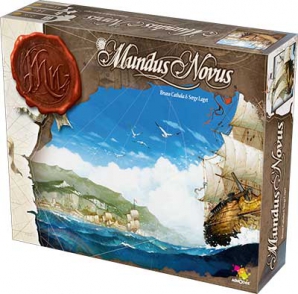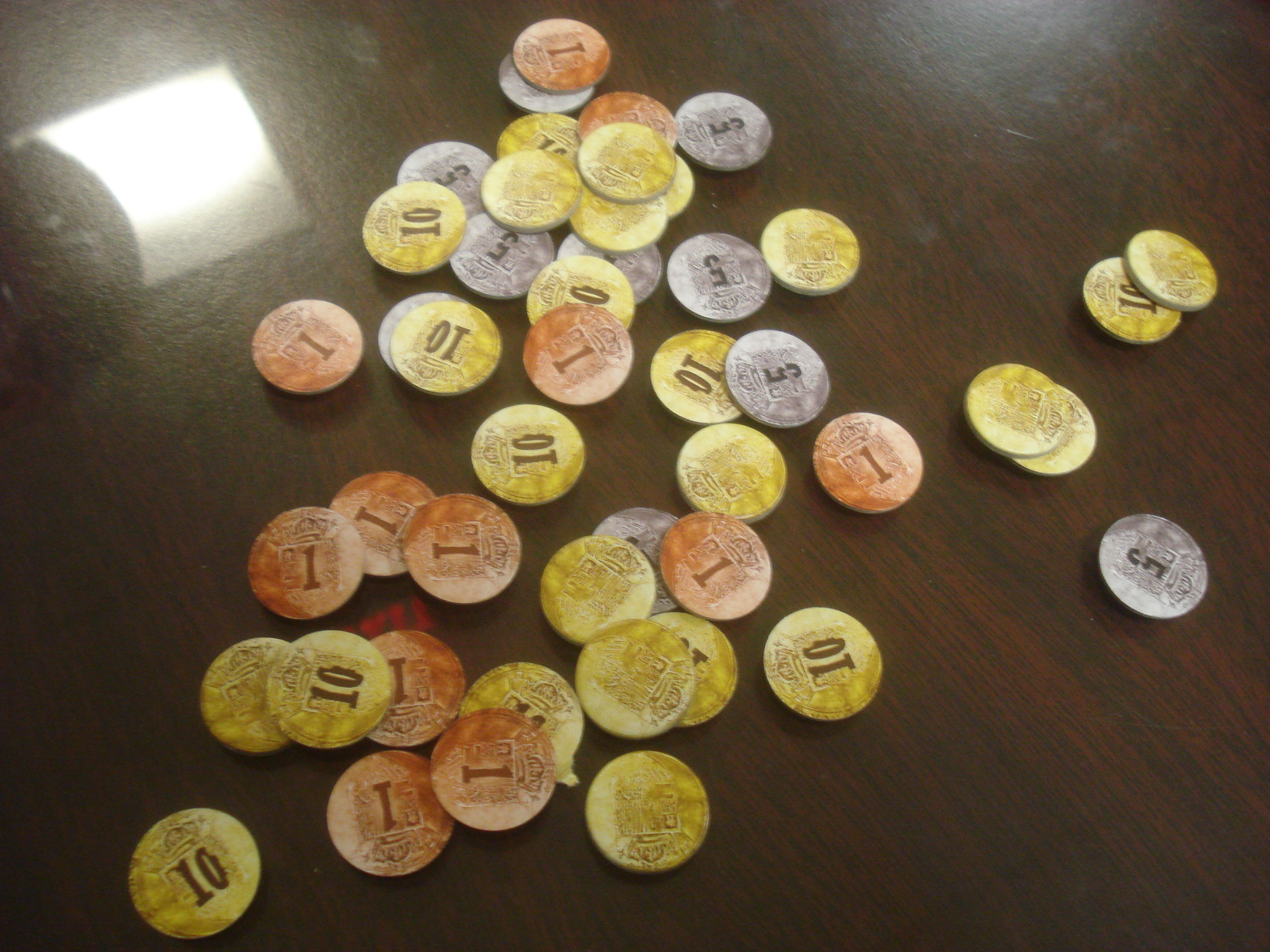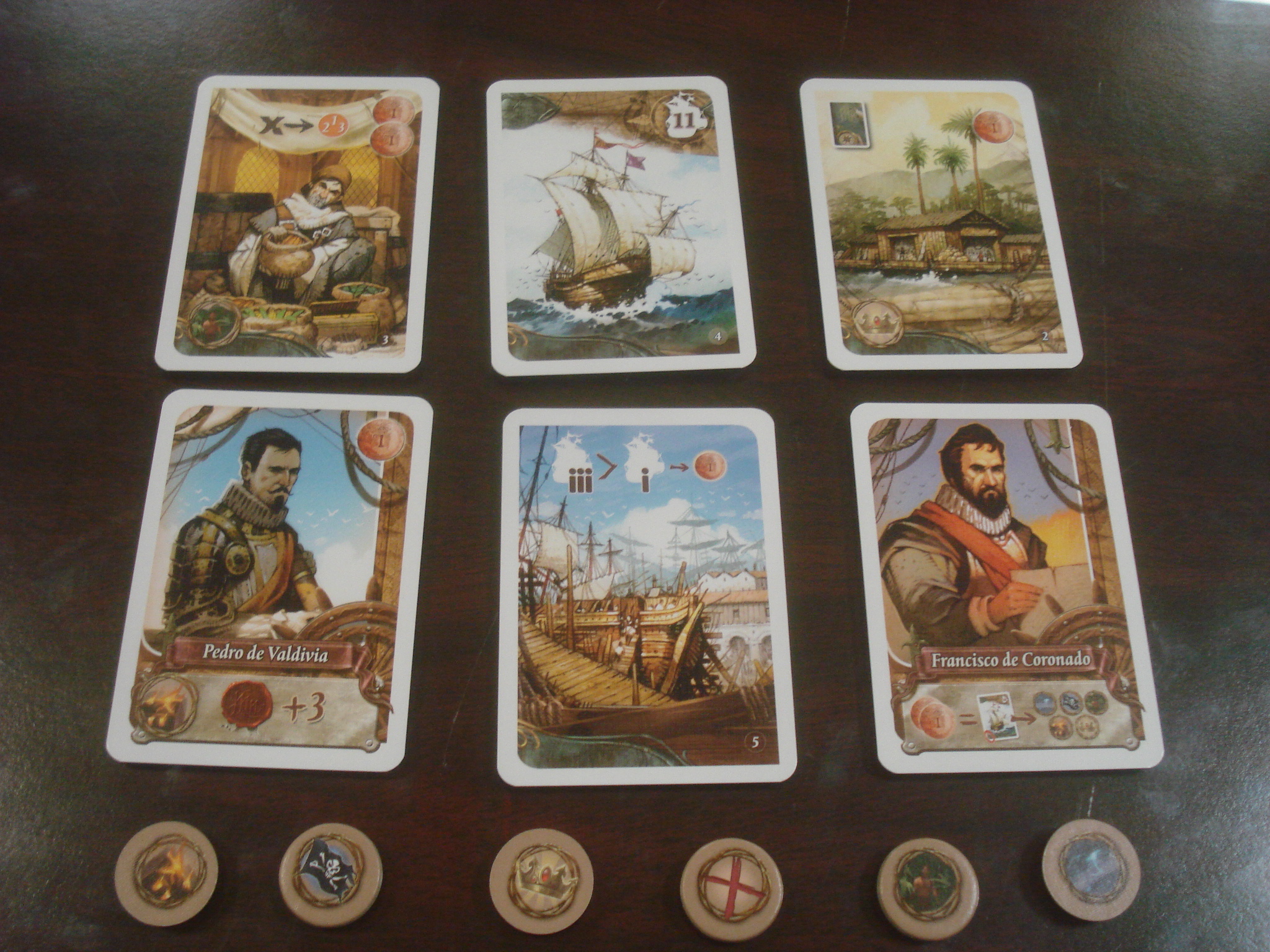| Publisher | Asmodee |
| Design Credits | Serge Laget, Bruno Cathala |
| Art Credits | Vincent Dutrait |
| Game Contents | 120 Resource cards, 44 Development cards, 90 Doubloon tokens, 6 event tokens, Trade Master token, rulebook (Dutch, English, French, German, Spanish), player aid |
| Guidelines | 16th-century conquistador trading game |
| MSRP | $29.99 |
| Reviewer | Andy Vetromile |
Ahoy, mateys! Time to set sail for new lands, ideally those that score you a fat bundle of cash. Mundus Novus, the new sailing and trading game from Asmodee, sends players on a quest to build fleets, gather stout explorers, and transport appealing cargo in their bid for gold during the age of conquistador colonization.
Two to six players become the patrons of their respective 16th-century merchant empires. They begin their investments with but a paltry hand of five cards, and the current Trade Master – a sort of “first player” position – names a number of cards from two to four. Everyone chooses and reveals that many cards from their hand simultaneously, to be used in trading. The cards show the various foods, goods, and spices everyone is after, and each “suite” has a number according to how rare it is.
Corn, for example, is a low number 2 because it’s easy to come by (there are 16 of them in the deck), while vanilla is the rare treat at number 9 and only eight of those are up for grabs. Finally there are several Inca relics to collect that serve as wild cards.
The player who unveiled the highest card total becomes the new Trade Master and decides whose card he wants. He puts the procured card into his hand, and the person from whom he chose gets the next selection. Players continue this chain, taking cards from each other, until all the face-up items are gone (there’s also a small market of extra cards with which the players may trade). With these new cards in hand, players can hopefully make a set of three or more of them, either all the same number (all 2s, for example) or all different.
If one can field different numbers, the return is in the form of Doubloons – four different goods are worth 5 gold pieces, but nine separate types would bring in 25.
Alternately, a player who gathers a set of the same good can purchase a Development card from the table, and the higher the suite number is, the more choices he can pick from. Development cards offer bonuses and abilities that drastically change the way the game plays. For every ship added to his fleet, for example, he gets another card in his starting hand each turn, and warehouses let him keep cards from turn to turn so he can make better sets. The merchant cards allow someone to treat one good as though it were another – suddenly your two 5s and one 3 become a full set of 5s. No age of South American conquest would be complete without explorers, though, and they’re waiting to be discovered in the deck as well. Each imbues you with some special power, and most give you Doubloons each turn into the bargain. He may make your goods worth more for determining who becomes Trade Master, or he might protect you from events (some Development cards list events, and most of them are bad news like cargo-thieving pirates or fires that prevent warehouses from retaining goods).
Players grow their businesses until one of three victory conditions is met: reaching 75 Doubloons; presenting a perfect set of all 10 card types; or, should the Development deck run out first, having the highest Doubloon total.
The presentation of the game is really nice. You get a portrait of conquistador life courtesy of artist Vincent Dutrait, and the rules go into greater depth by giving a thumbnail sketch of each explorer’s life and accomplishments. The coins are thick, the cards seem sturdy, and the Trade Master token is similarly rugged. The rules are pretty well presented, and though it sports a few typos like many translations, nothing in it stops game play.
The rules are a reimplementation of the trading system from Mare Nostrum by Serge Laget and Descartes Editeur, with an able assist from Bruno Cathala. For such a small package, they certainly fit a whole lot of strategy into the mix. There are several paths to victory, and you can never get all the goods or cards you want to seal up the holes in your approach. There’s always something left to buy, and everyone else has a different idea on how to go about reaching the top. The actions of others may be tantalizingly within your grasp, making interaction possible but interference uncertain as you try to undermine their attempts at securing that “perfect hand” of ten or whatever other strategy they employ – you can see it, but it’s a close call whether you can do anything about it.
For anyone worried about the complexity of trading games, this is a pretty gentle way to get into one. It’s never overwhelming, and there’s not really a bad play to be made unless one simply doesn’t focus one’s efforts. It’s quick, so it won’t take up the entire evening (though if you want it to you can easily fit a game into an hour), but it does this without sacrificing opportunity and depth of play. Mundus Novus may be a retread of an older entry, but the lands it opens up surely feel fresh and fun.



